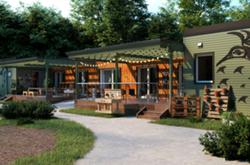
The sun is just a hazy glow behind thin cloud cover, but still high in the sky over Vancouver on this June evening, one of the longest of the year.
Today the solar panels on Doug Horn's roof generated enough electricity to power his small North Vancouver home for roughly 48 hours.
Horn installed the panels two years ago with help from Vancouver's Renewable Energy Co-operative. Once an electrician inspected the wiring, BC Hydro installed a net-meter to measure the amount of electricity coming from and going to the grid, and Horn was in business... kind of.
It will take him roughly 250 years to pay off his $15,000 investment based on the value of the electricity it produces.
For Ontario homeowners, however, investing in solar pays off in something more like 25 years, thanks to a feed-in tariff for renewables that was introduced last year in the province. It offers 42 cents per kilowatt hour for solar electricity, and around 11 cents per kW-h for wind and bioenergy.
Tying small producers into the grid
In a year's time, the Ontario Power Authority achieved what it intended to do over 10 years: secure 10,000 MW of small-scale renewable energy. It's made power producers out of urbanites, farmers and community co-ops.
A group of Toronto homeowners were among the first group to take advantage of the offer -- which is currently on hold as it undergoes review -- with help from the Toronto Renewable Energy Co-op.
They formed the West Toronto Solar Initiative, and by pooling their resources were able to get a good deal on the solar system components and also hire a Waterloo consulting firm to handle all the paperwork required to enter into a standard offer contract with the Ontario Power Authority.
"We were really looking for a genuine turn-key solution," says Ken Traynor, a WISE volunteer and member of the renewable co-op board.
"It was a learning experience all around... but by the end it was happening much quicker and much more straightforwardly. We feel we made a contribution to the whole process."
"It's really valuable to have a significant portion of Toronto's energy needs being met from sources within Toronto," he adds.
"And there's lots of potential uptake by people out there."
'Lot of talk, no government incentives'
Kevin Pegg, president of Alternative Energy, a renewable energy supplier in Victoria, says many B.C. homeowners are also interested in power generation.
His company supplies all the components of renewable electricity systems, from solar panels to micro turbines to batteries and inverters.
Traditionally, his clients have been off-grid -- people looking to power research stations, fishing lodges, hunting camps and other remote properties.
Now, he says, there is more interest from urban residents. On the positive side, he says, systems are become easier to install and cheaper, with prices continuing to drop, says Pegg.
On the negative side, he says, there still isn't enough support from the provincial government to make installing a system worthwhile for many.
"This trend has probably been one of the more challenging trends that we've seen over the last few years," says Pegg.
"There's a whole lot of talk, a whole lot of interest from consumers, but there are no government incentives whatsoever."
British Columbia does offer PST breaks on renewable systems, and BC Hydro's net-metering and standing offer program are two avenues that allow customers to tie their systems into the grid (provided they have access to a transmission line).
One of the barriers to living off-grid is the fact that electricity storage is costly. A grid-tie makes it possible to draw power from other sources when the wind is not blowing or the sun not shining, but Pegg says it is not a "magic pill" to achieve green power.
Efficiencies yield savings
"The grid tie is part of an overall process where someone is trying to lower the amount of energy their household uses," says Pegg.
"It has to do with the economics of everything. Every dollar you spend on efficiency, you save five on generation."
This is a formula Horn knows well. Before installing his system, he knocked his power usage down from 15 to 3 kW hours per day -- as much as his old fridge alone was sucking -- by replacing appliances and light bulbs and switching his electronics to a power bar.
"If you don't do the energy efficiency stuff, putting the PV panels on is more of a statement than anything else," says Horn.
"We've become accustomed to using so much energy so easily."
The provincial government has set a goal to meet 50 per cent of the province's forecasted energy needs over the next 20 years -- about 10,000 GW-h -- through conservation.
One of its tactics in achieving this is to reduce the demand, through campaigns, incentive programs for efficiency upgrades and penalties for over-consumption.
Upping the kilowatt cost
Next October, BC Hydro consumers will be charged an extra .70 cents for every kilowatt hour of electricity they use beyond a fixed amount.
However, in terms of overall energy conservation, addressing our heating and hot water demands are just as important.
Two-thirds of the average home's energy consumption is thermal, everything from showers to dishes to drying clothes.
And, in British Columbia, about 90 per cent of those homes use natural gas to meet these energy needs.
Terasen Gas, the largest natural gas provider in the province, serves 900,000 clients in 125 communities. According to its figures, the typical Lower Mainland mid-sized home uses 43.2 GJ of natural gas per year -- that's equal to two tonnes of carbon.
With rising natural gas prices and now a carbon tax to answer to, municipalities are taking conservation more seriously, and they are also looking closely at bioenergy options.
Next Tuesday, in the last in this series, we look at whether burning waste can be a sustainable source of energy.
Related Tyee stories:
- BC Hydro's Amazingly Bad Deal for Ratepayers
We give big firms $15 billion. We get higher prices, no assets, no guarantee of supply. - In Telkwa, Surviving Off the Grid
It's minus 34 tonight and the generator just quit. Why did we say no to Hydro? - Global Warming Demands Local Fixes
Half of greenhouse emissions are controlled at municipal level.
Read more: Science + Tech, Environment
















Tyee Commenting Guidelines
Comments that violate guidelines risk being deleted, and violations may result in a temporary or permanent user ban. Maintain the spirit of good conversation to stay in the discussion.
*Please note The Tyee is not a forum for spreading misinformation about COVID-19, denying its existence or minimizing its risk to public health.
Do:
Do not: